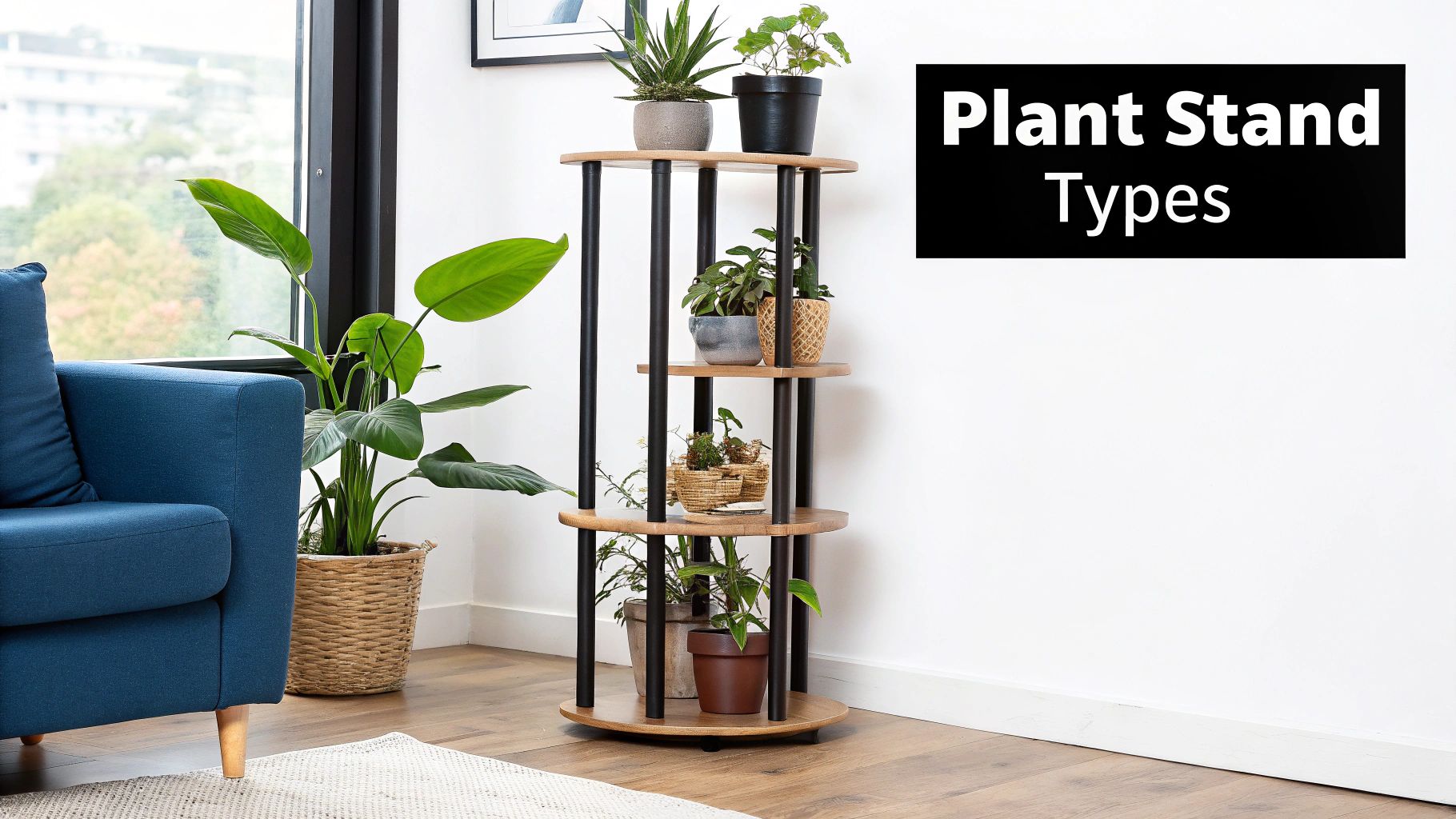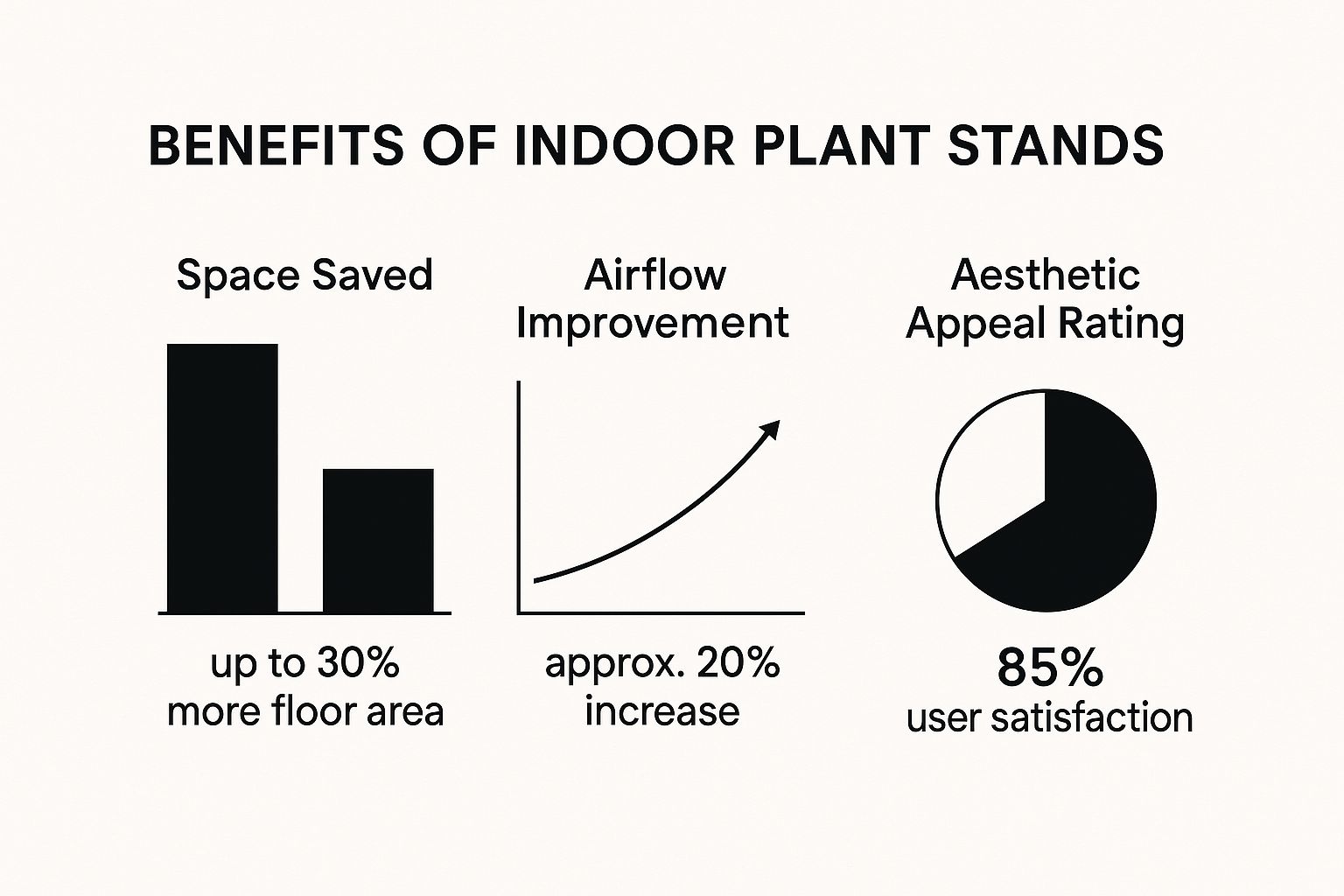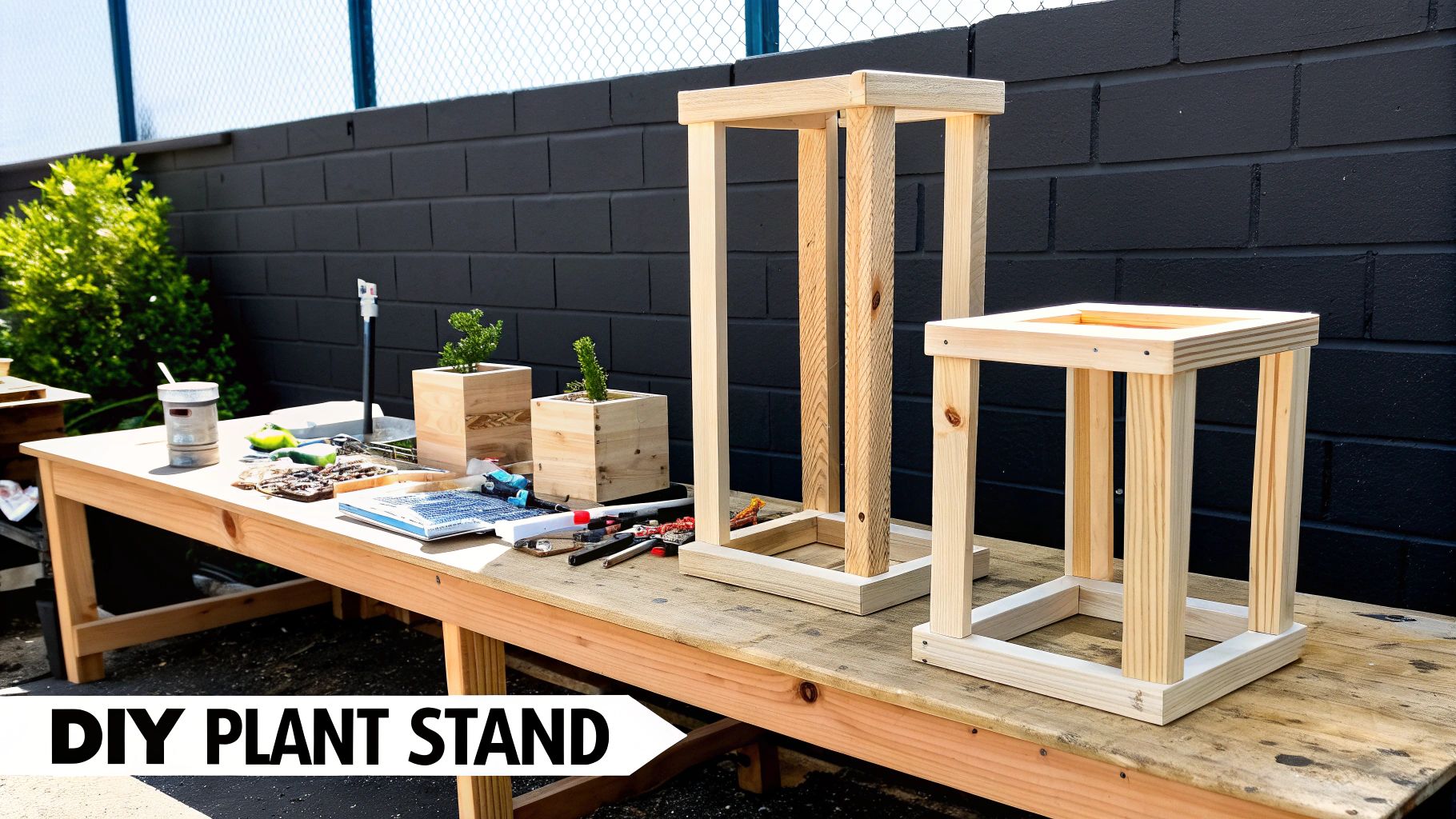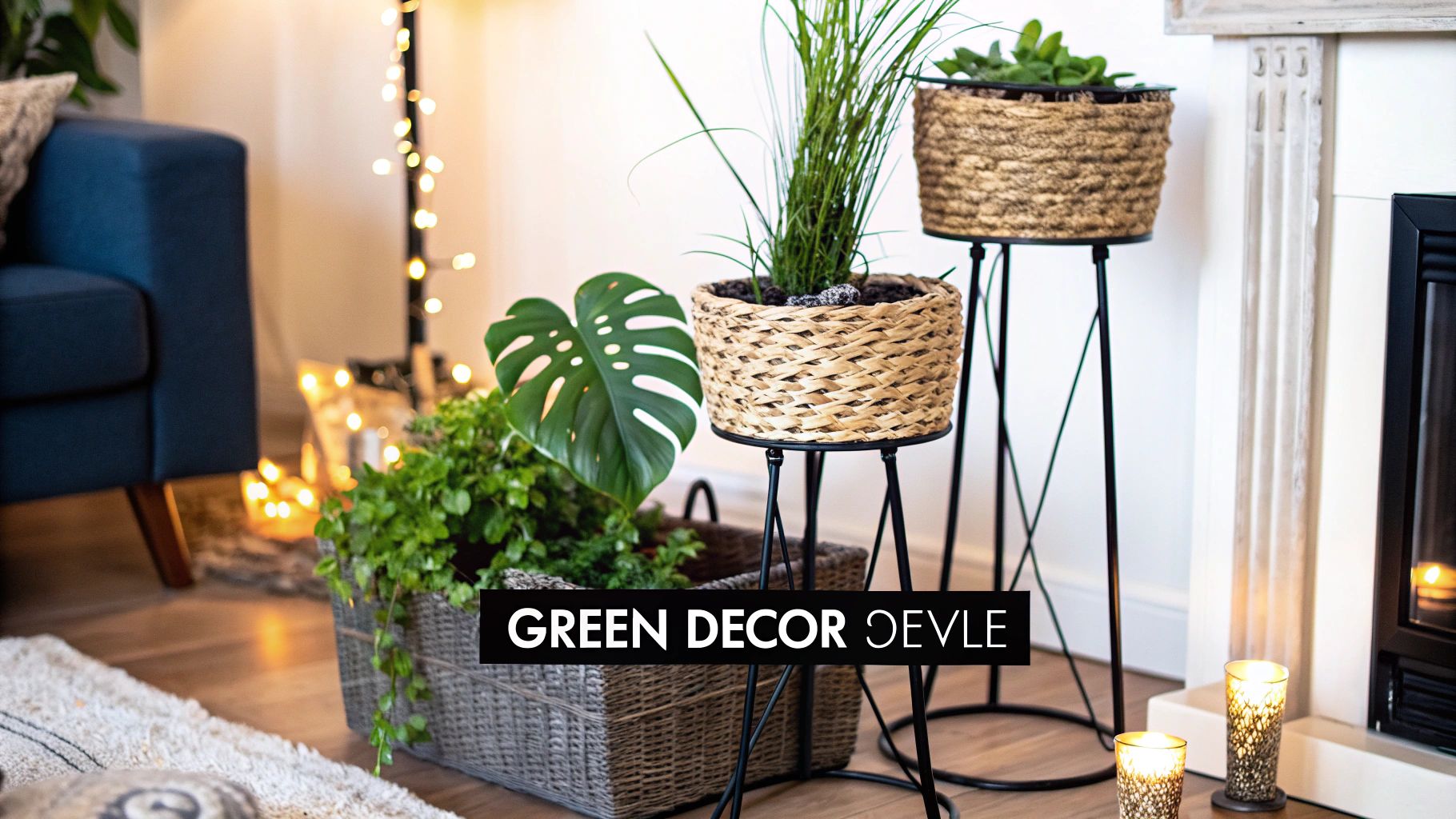Think of an indoor plant stand as more than just another piece of furniture. It's the secret to turning your collection of houseplants from a simple hobby into a stunning feature of your home's decor. A stand gives your greenery a platform, transforming a humble pot plant into a genuine statement piece that enhances both your plant's health and your home's style.
More Than Just Furniture: Why Plant Stands Matter
Let’s face it, a plant stuck on the floor can sometimes look a bit lost or like an afterthought. Now, imagine lifting that same plant onto a stand. Instantly, it has presence and commands attention. This simple act is the key to unlocking a whole new level of interior styling, turning your plants into a curated display of living art. The best indoor plant stands are functional workhorses beautifully disguised as decor.
They are especially brilliant for anyone living in a smaller space, a common reality in many Kiwi homes. Instead of cluttering up precious floor area, stands let you build your greenery upwards. You can create lush, green corners without sacrificing room to move, a clever trick that also draws the eye upward and makes a space feel bigger and more alive.
The Health and Wellbeing Connection
Beyond just looking good, plant stands are genuinely beneficial for your plant's health. Getting a plant up off a cold floor dramatically improves its access to two things it desperately needs to flourish: light and air.
- Better Light Exposure: Hoisting a plant up brings it closer to the window, helping it soak up that all-important bright, indirect light. This is a game-changer, particularly during New Zealand's shorter, darker winter days.
- Improved Air Circulation: Good airflow around the leaves and soil is your best defence against common problems like mould, fungal growth, and pests. A stand allows air to move freely all around the pot, which helps the soil dry out properly and keeps the roots healthy.
By giving your plants a literal lift, you're directly investing in their long-term health and vibrancy. And a thriving plant does wonders for your own sense of wellbeing, creating a healthier, happier home environment.
Ultimately, choosing to use an indoor plant stand is all about being intentional with your decor. It signals a thoughtful approach to bringing nature inside, carefully considering how and where your plants will look their best. This considered placement elevates the whole atmosphere of your home, helping you create a calming, stylish sanctuary that truly reflects your personal taste.
Finding the Perfect Style for Your Home Décor

Choosing an indoor plant stand is a bit like picking out a frame for a favourite piece of art. It’s not just about holding the plant; it’s about complementing your home's unique personality and making your greenery feel like a deliberate part of the design. The right stand can tie everything together, turning a simple pot plant into a stylish focal point.
Luckily, you don't need to be an interior designer to get it right. By getting to know a few key styles, you can quickly figure out what speaks to you and find a stand that looks like it was custom-made for your space. Let’s dive into some of the most popular looks out there.
Mid-Century Modern Simplicity
Defined by its clean lines, organic curves, and a "less is more" attitude, Mid-Century Modern is a style that never seems to fade. Indoor plant stands in this aesthetic typically have slender, tapered wooden legs and a simple structure that lets the plant be the star of the show.
They’re wonderfully versatile, fitting just as well in a minimalist flat as they do in a classic villa. Think of them as the perfect supporting actor—they elevate your plant without ever trying to steal the spotlight. This style is an easy win if you appreciate understated elegance and functional design that always feels fresh.
Mid-Century Modern stands are so effective because they champion simplicity. Their design is built on the idea that form follows function, creating a piece that’s both beautiful and practical, enhancing your plant and your room.
Bohemian and Natural Textures
The Bohemian (or Boho) look is all about crafting a relaxed, eclectic, and nature-driven vibe. When it comes to plant stands, this means plenty of natural materials and handcrafted details. Rattan, wicker, and light-coloured woods are the true heroes of this aesthetic.
You'll often find stands with intricate woven patterns, macramé hangers, or a more free-flowing, organic shape. A Boho stand instantly adds warmth and texture, making a space feel more grounded and inviting. If your home is already full of soft textiles, natural fibres, and unique artisanal treasures, a Bohemian plant stand will feel right at home. Still figuring out your signature look? Our guide on finding your personal style has some great pointers.
Industrial and Urban Edge
If you’re after something a bit bolder with a contemporary feel, the Industrial style is a fantastic choice. It pulls its inspiration from old factory workshops and city lofts, celebrating raw, stripped-back materials.
Look for indoor plant stands crafted from materials like:
- Black Metal: Powder-coated steel or iron creates a strong, graphic outline.
- Raw Wood: Unfinished or reclaimed timber brings in a rustic, authentic element.
- Concrete: A stand made of or finished with concrete gives off a cool, minimalist, and substantial feel.
Industrial stands are brilliant for modern apartments, minimalist interiors, or any room that could use a touch of structured, urban cool. They create a stunning contrast with the soft, organic forms of your plants, making the foliage really pop with life and colour.
Choosing a Material That Lasts and Looks Great
The material of your plant stand does more than just look good—it’s a practical choice that dictates durability, where you can place it, and the entire vibe of your room. It’s a bit like picking a jacket. A linen blazer is perfect for a sunny afternoon, but you wouldn't wear it in a storm. The same thinking applies here.
You’ve got to match the material to the environment. That gorgeous, raw pine stand might be a showstopper in the living room, but it could quickly warp or stain in a steamy bathroom. Knowing the pros and cons of each material means you can pick a piece that not only complements your style but will also stand the test of time.
Wood: For Warmth and Natural Beauty
There's an undeniable warmth and organic feel that wooden plant stands bring into a home. They’re incredibly versatile, from the clean, light lines of birch to the deep, rich tones of oak or acacia, fitting in with almost any interior design. It's a classic choice that beautifully connects your indoor plants back to their outdoor roots.
Just remember that not all wood handles moisture the same way. For high-humidity spots like kitchens or bathrooms, you'll want to go for hardwoods or wood that has been properly sealed to fend off water damage. If you’re passionate about sustainability, opting for stands made from reclaimed or responsibly sourced wood can be a lovely part of your eco-friendly home decor strategy.
Metal: For Sleekness and Modern Strength
If you’re chasing a modern, industrial, or minimalist aesthetic, metal is a fantastic choice. Materials like powder-coated steel and wrought iron are incredibly strong and durable, making them perfect for supporting those heavy ceramic pots. Their slim profiles often create an illusion of space, letting the plant itself be the star of the show without adding visual clutter.
Metal stands are particularly brilliant for high-moisture areas. A good powder-coated finish acts as a tough barrier against rust, so you can confidently place them in a steamy bathroom or next to the kitchen sink without a second thought.
Rattan and Bamboo: For a Softer, Bohemian Touch
For a more relaxed, coastal, or boho vibe, you really can't go wrong with rattan and bamboo. These natural fibres are surprisingly strong for how lightweight they are, and they introduce a beautiful, handcrafted texture that instantly softens a room. They look especially good with lush, leafy plants like ferns or trailing pothos, helping create a peaceful, laid-back atmosphere.

Here's a quick rundown to help you compare the most common materials at a glance.
Indoor Plant Stand Material Comparison
| Material | Aesthetic | Durability | Best For | Care Level |
|---|---|---|---|---|
| Wood | Warm, natural, classic | Varies; hardwoods are best. Sealing is crucial. | Living rooms, bedrooms, dry areas. | Medium |
| Metal | Modern, industrial, sleek, minimalist | Very high, especially if powder-coated or sealed. | Any room, including high-humidity bathrooms. | Low |
| Rattan/Bamboo | Bohemian, coastal, relaxed, textural | Good, but best for lighter pots. | Covered patios, living areas, bedrooms. | Low to Medium |
| Ceramic/Stone | Elegant, heavy, statement-making | Excellent, but can chip or crack if dropped. | Stable surfaces, formal spaces. | Low |
Each material brings its own personality to the table. Choosing the right one is all about balancing the look you want with the practical needs of the plant and its location in your home.
Here in New Zealand, the houseplant trend is still going strong, and the huge variety of stands available reflects that. You can find simple wooden designs starting from around NZD 54, while more premium, designer pieces can go for over NZD 199. It’s clear Kiwis are happy to invest in both style and quality when it comes to showing off their green companions.
How to Select the Right Stand for Your Plant and Space
Choosing the perfect indoor plant stand isn't about following strict rules. It's more like playing matchmaker—you're looking for that sweet spot where your plant, your pot, and your room all click. The right stand does more than just hold a pot; it elevates the whole look, making your plant a real feature in your home.
Taking a moment to think through a few key things will help you find a stand that feels like it was made just for your space. It's the difference between a plant just sitting in a room and one that truly brings it to life.
Sizing Up Your Pot and Your Room
First things first, let's talk measurements. It’s a simple step, but one that’s easy to get wrong. A classic mistake is grabbing a stand that’s too small, leaving your pot teetering precariously on top. On the flip side, a stand that’s way too big for its pot can just look clumsy and out of place. You want the base of your pot to sit squarely on the stand's surface, nice and secure with no major overhang.
Just as important is how the stand fits into the room itself. A big, chunky stand can completely dominate a small living area, while a tiny, spindly one will get totally lost in a large, open-plan space. If you're working with a smaller home, making every square metre count is key. You can find some great inspiration from clever small space storage ideas to really get the most out of your layout.
A well-chosen plant stand should feel like a natural extension of your room's decor, not an afterthought. It should complement the proportions of your furniture and the overall flow of the space.
Single Stand vs Multi-Tiered Solutions
This choice really boils down to your plant collection and what you're trying to achieve. Do you have one absolute stunner of a plant you want to put on a pedestal, or are you aiming to create a lush green jungle in one corner?
- Single Pot Stands: These are your go-to for showing off a "hero" plant. Think of a magnificent Fiddle Leaf Fig or a sculptural Monstera that deserves its own moment in the spotlight. They create a single focal point and are brilliant for framing an armchair or bringing an empty corner to life.
- Multi-Tiered Stands: If you've got the plant bug bad, a tiered or ladder-style stand is a total game-changer. It lets you create a vertical garden, which is an incredibly savvy way to show off lots of plants without chewing up precious floor space.
Strategic Placement for Light and Life
Where you put your stand makes all the difference, both for your plant's health and the feel of the room. Before you get your heart set on a spot, spend a day watching how the light moves through the space. Most indoor plants are happiest with bright, indirect light, so a spot near a window—but not directly in the path of harsh, scorching sun—is usually perfect.
Think about foot traffic, too. A stand plonked in a busy hallway or right beside a doorway is just asking for trouble, especially if you have trailing plants. You want to place it somewhere it can be admired without being constantly bumped or brushed past.
Prioritising Safety for Kids and Pets
If you have curious toddlers or boisterous pets running around, stability is everything. When you're shopping, look for an indoor plant stand with a low centre of gravity and a wide, solid base. Designs with splayed legs are far more stable than those with straight, narrow ones.
Give it a gentle wobble test in the shop. If it feels shaky there, it’s definitely not going to work in a busy home. It's also worth double-checking that the plants you're displaying are non-toxic, just in case any little hands or furry friends decide to have a taste.
Creative Styling Ideas with Indoor Plant Stands

Alright, you’ve picked out the perfect indoor plant stand. Now for the really fun part! Styling is where you get to graduate from just having plants to using them as a genuine interior design tool. A thoughtfully styled stand can do so much—it can frame a piece of furniture, bring depth to a room, and really let your personal style shine.
Think of your stands as the building blocks for creating little living vignettes around your home. It’s about more than just getting your plant off the floor; it's about playing with composition to create something visually interesting. This is how you turn a simple collection of plants into a cohesive, stylish feature that breathes life into your space.
Create a Dynamic Plant Corner
One of the most powerful ways to use indoor plant stands is by grouping them to create a dedicated 'plant corner'. This is all about clustering several stands of different heights and styles to build a lush, multi-levelled display. It's a fantastic trick for adding incredible depth and texture to a forgotten corner.
Here’s how to nail the look:
- Mix Heights and Styles: Try pairing a tall, slender stand with a shorter, chunkier one. Don't be afraid to mix materials either—the contrast between warm wood and cool metal always looks great.
- Vary Your Plants: Group plants with different foliage. Think about a structural, upright Snake Plant next to a soft, trailing Pothos to create a beautiful interplay of shapes and textures.
- Use the Rule of Three: There’s a reason designers love odd numbers. Grouping three or five stands together almost always looks more natural and appealing than an even-numbered arrangement.
This approach turns a few individual plants into a curated indoor garden, making a real statement in a living room or study. If you’re looking for more ways to fill your home with greenery, our guide on creating a space with endless foliage has some great ideas.
Style Beyond the Living Room
Don't just keep your beautiful plant displays to the main living areas! Placing a plant stand in an unexpected spot can bring a lovely touch of nature to parts of the home that are often overlooked. A slim stand in a bathroom can instantly create a calming, spa-like feel, while a small one on your home office desk can help you feel more focused and less stressed.
Using plant stands in unconventional spots is a simple trick to make your entire home feel more connected and thoughtfully designed. It shows an attention to detail that elevates the overall ambience.
This whole idea taps into a wider shift in how we Kiwis are thinking about gardening. As more of us live in cities, the focus is naturally moving towards clever, space-saving indoor solutions rather than sprawling outdoor gardens. It's a trend that's reflected in the garden supplies market, too. You can read more about this evolving market on IBISWorld.
By thinking a little creatively, you can use indoor plant stands to highlight your home’s best features, soften hard lines, and bring a bit of life into every nook and cranny. Whether you’re framing a sofa or brightening a hallway, your stands are the key to a more vibrant, personalised home.
Why Indoor Gardening Is More Popular Than Ever
Have you noticed more and more of your friends' homes filling up with lush, leafy plants? If you’ve felt that same pull to bring a bit of nature inside, you're definitely not alone. There's a real, tangible shift happening as people everywhere are rediscovering the simple joy of indoor gardening.
This isn't just a fleeting trend. It feels more like a response to our increasingly busy, urban lives. As our worlds get faster and our living spaces often get smaller, that need to connect with something natural and grounding becomes stronger than ever.
Houseplants are the perfect answer. They’re a beautiful and accessible way to carve out a little sanctuary for yourself, a pocket of peace amidst the daily hustle. Beyond just looking good, they help clean the air and soften the concrete edges of modern homes, adding a vibrant, living energy. And using indoor plant stands is a brilliant way to elevate this, turning a few pots into a thoughtfully curated green display.
This isn't just a hunch either; the numbers back it up. The global indoor plant market is booming, expected to grow at 4.85% each year between 2025 and 2034. It's clear that people are actively seeking out the aesthetic and wellness benefits that plants bring into a home. For a deeper dive into these market trends, you can check out the analysis on Custom Market Insights.
Joining this green movement is about more than just buying a plant. It’s a conscious choice to create a healthier, more beautiful living space—one that nurtures both you and your leafy friends.
This is all the encouragement you need to start your own plant styling adventure. Whether you have a jungle of your own or are just bringing home your very first succulent, understanding this bigger picture can give you the confidence to get creative. For a bit of seasonal inspiration, have a look at our tips for kickstarting your spring planting and see how easy it is to bring that fresh energy indoors.
Common Questions About Indoor Plant Stands

Even after you've browsed all the styles and materials, a few practical questions can pop up. That's completely normal. Nailing these last few details is what turns a good choice into the perfect one for your space.
Let's run through some of the most common queries I hear from people. Getting these answers sorted will help you feel completely confident in your final decision.
What Is the Best Height for an Indoor Plant Stand?
Honestly, there’s no single "best" height – it's all about context. The right height completely depends on where the stand is going and what plant will live on it. If you have a plant on the floor that's desperate for more light, a taller stand is a brilliant way to lift it up into the sunbeams from a nearby window.
For creating a really stunning display, my best advice is to vary your heights. Grouping stands of different levels adds depth and visual interest to a corner. A good rule of thumb is to elevate your plant so the bulk of its foliage is at a comfortable eye level, whether you're typically sitting or standing in that part of the room.
Can I Use an Outdoor Plant Stand Indoors?
You absolutely can, but there are a couple of things to watch out for. Outdoor stands, particularly those made from wrought iron or sealed wood, are built tough. The main thing to consider is the style – some outdoor designs can feel a bit chunky or rustic for a more refined indoor setting.
The most important check? Make sure it has soft pads on its feet to avoid scratching your floors. And always give a stand that's lived outside a really good clean before bringing it in. You don't want to accidentally invite any little garden critters into your home!
How Do I Know if a Plant Stand Is Stable Enough?
Stability is crucial; you don't want any wobbles. The first thing to check is the manufacturer's recommended weight capacity. A well-built, sturdy stand will usually have a low centre of gravity, which you’ll often see in designs with splayed legs or a wide, solid base.
Before you buy, give it a gentle nudge. It shouldn't feel rickety or top-heavy. If you have a particularly heavy pot, like a large ceramic or concrete one, you need to go for a seriously robust material like solid hardwood or steel. And make sure the base of your pot sits squarely on the stand's surface, with no overhang.
Ready to lift your greenery to new heights with pieces that blend timeless style and exceptional quality? Explore the curated homewares collection at The Foxes Den and find the perfect foundation for your indoor garden. Discover our collection at https://www.thefoxesden.co.nz.


